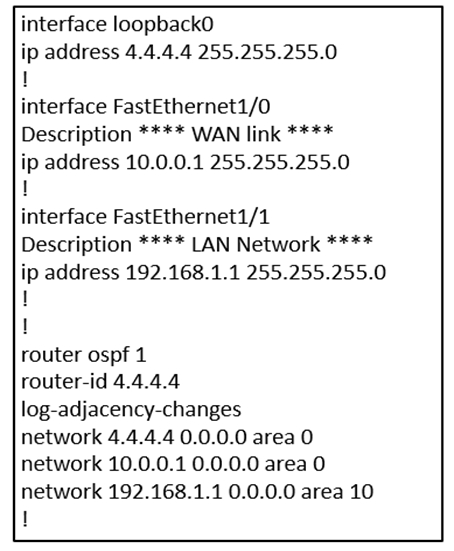Refer to the exhibit.

Which set of commands restore reachability to loopback0?
Refer to the exhibit.

Which set of commands restore reachability to loopback0?
In OSPF, loopback interfaces are treated as host routes by default, meaning they are advertised with a /32 mask. This can cause issues if the network requires the loopback interface to be advertised with its configured subnet mask, such as /24 in this case. To restore reachability with the correct subnet mask, the command 'ip ospf network point-to-point' should be applied under the loopback interface. This command forces OSPF to advertise the loopback interface with the configured mask instead of the default /32 host route. Thus, the correct set of commands to restore reachability to loopback0 is option A.
I understand the answ, but please, somebody explain, to me how the original config can make 4.4.4.4 unreachable. Thanks !
I believe it is because the route is advertised as a /32 (since OSPF does that by default for loopback interfaces). In order for it to be advertised properly as a /24, the configuration shown in A should be done.
Having the route advertised as a /24 or /32 really doesn't matter - 4.4.4.4 would be reachable in both cases. The phrasing of the question is absolutely terrible...
Point is that if you configured the loopback as a /24 is because you need the whole /24 to be advertised as well (for other purposes like NATed addresses). Otherwise you would configure the loopback as /32.
Loopbacks are considered host routes in Open Shortest Path First (OSPF). To make OSPF advertise the loopback subnet as the actual subnet with the loopback mask, instead of as host route /32, issue the ip ospf network point-to-point command under the loopback interface. For more information, refer to the 9.1. Interface States section of RFC 2328.
The question is really horrible as mentioned by @bogd, with the current interface and ospf configuration, the loopback would also be reachable.
Fully correct, the loopback would be reachable however it would advertise /32 instead of a /24. So there is no need to correct any configuration, changing it would only advertise different mask, but you would not be able to reach any other interface in the actual advertised network. Stupid question.
I have tested the lab, i could still reach the loopback, OSPF advertised a /32 route for the loopback by default. But i would go for the option A for the exam
Here's the explanation: https://networkengineering.stackexchange.com/questions/13099/why-do-we-use-ospf-point-to-point-networks-for-loopbacks
The network type broadcast is not accepted in the loopback interfaces. R4(config-if)#ip ospf network broadcast % OSPF: Invalid type for interface Loopback0 So for allow to exchange the loopback as not as a /32 network the only option that we have is use the command ip ospf network point-to-point command under the loopback interface
In case you are going to redistribute the loopbacks instead of advertising these loopbacks with the network command then they will be advertised with the /24 even without the ip ospf network point-to-point command under the loopbacks R4#show running-config interface lo0 Building configuration... Current configuration : 62 bytes ! interface Loopback0 ip address 10.1.0.1 255.255.255.0 end R4#sho R4#show run R4#show running-config | sec router router ospf 1 redistribute connected subnets network 192.168.24.0 0.0.0.3 area 0 network 192.168.34.0 0.0.0.3 area 0 R4#
R1#show ip route 10.1.0.0 Routing entry for 10.1.0.0/24 Known via "ospf 1", distance 110, metric 20, type extern 2, forward metric 20 Last update from 192.168.12.2 on Ethernet0/0, 00:16:54 ago Routing Descriptor Blocks: * 192.168.13.2, from 10.4.0.1, 00:16:54 ago, via Ethernet0/1 Route metric is 20, traffic share count is 1 192.168.12.2, from 10.4.0.1, 00:16:54 ago, via Ethernet0/0 Route metric is 20, traffic share count is 1 R1#
A is correct